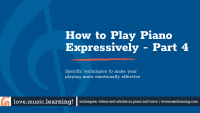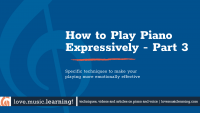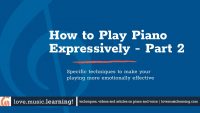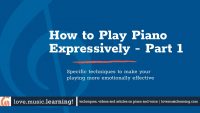Practice S-L-O-W-L-Y
I can’t stress this enough. I even typed it slowly for emphasis. Most people who have studied some piano are aware of the concept of slow practice, but many do not employ this technique to its fullest potential. You may even be wondering why this would be a part of Creative Practicing that is supposed to engage the mind – isn’t slow practice extremely dull? Well, you’re not totally wrong: slow practice can actually be quite ineffective (and dull) if not done properly! It’s important to know first of all what exactly does slow practice mean, when to use slow practice, how frequently you should use it. So if you have found that the sage advice of practicing slowly just doesn’t seem to help, read on and discover why not and how to transform your practicing with proper use of this technique.
It’s not just enough to play slightly under tempo, it’s has to be slow enough that it’s easy to play.
How Slow is ‘Slow’?
If you’re stumbling over fingering or you feel tension building in your forearms then it’s probably too fast. That’s probably a pretty easy assumption, and so you slow down a bit – just enough so that you can passably play the piece. For some reason, however, this doesn’t seem to help much. Anytime you try to go faster, you run into that same brick wall of tension, or your fingers don’t seem to want to go any faster. Sound familiar? The problem here is that you are still playing to quickly.
Slow practice does not mean find the fastest tempo you can actually play a passage without tension or mistakes, it means to practice so slow it sounds stupid. I say this not to be insulting to the music, but to drive home the point just how slow you need to go. Pushing the envelope of speed in a passage that is tricky for you does not help at all – as you’ve probably figured out if you’ve done that before. You could spend weeks doing that and not make progress, and what could be more frustrating?
I see this all the time with beginner students: every single piece is done at the same speed! We have to teach ourselves to play slower or faster than this default tempo. So it comes to no surprise that we chaff at practicing slow enough to be effective. So if you practice so slow it sounds stupid, well, you’re probably at the right speed for slow practice.
Often it is our thought-process that’s getting in the way. We think, “I should be able to play this at tempo,” and so we go at it at tempo again and again. We get angry with ourselves because we make the assumption that whatever we are trying to do should be easy right out of the gate, or after 2 weeks of practice, or whatever standard we’ve set for ourselves. But whatever it is, the fact remains that we cannot play this passage at tempo….yet. And going at it in the same manner over and over again doesn’t yield results. Once we come to terms with this and get our fragile egos out of the way, then we’re ready to really make progress.
If you practice so slow it sounds ‘stupid,’ well, you’re probably at the right speed for slow practice!
Why Practice Slowly?
Still not convinced about slow practice? Here’s an illustration that might be a familiar experience: Imagine someone is giving you directions to a place you’ve never been before. You’re somewhat familiar with the area, but they start racing through the directions, giving you no time to process what’s being said let alone visualize where you might be headed. After the first 3 steps, you’re completely lost, and you ask them to start over again, so they do the same thing just as fast – and the scenario repeats. Of course, you’re still lost and request that they start over again, but this time slower. So they pause after each step, giving you time to visualize where you are at each point along the way, and you understand exactly where you need to go.
Notice that matter how many times they sped through the directions, you weren’t getting it, but the one time slower was all you needed. Even though it took more time to tell the directions slower with the pauses in there, overall, it was much quicker in delivering the directions to you so you could understand than speeding through time and time again. This is the same for slow practice in piano: going slowly enough gives your brain time to process what it’s doing and know where it’s going, and doing so actually saves you practice time in the long run. In other words, slow practice gets you there faster!
How to Practice Slowly (and not get bored)
Even if you do use slow practice, it can still be a problem. After all, if you’re just playing through the entire piece slowly, it’s going to be even more mind-numbing than playing up to tempo 3 times in a row. So the difficult part is keeping your mind engaged while you play slowly. If you have a specific intention for practicing slowly, your mind will still be able to pay attention.
- Do it in small sections and only in the problem areas. Not all music in a piece is equally difficult (if it is, you are probably playing music that is too hard for you), so not every part of a piece need be practiced every day or have the same practice techniques applied to them. Why waste your time on what’s not a problem? Or why waste time applying a technique that doesn’t directly address the issue? Save time by using slow practicing in certain passages, or breaking up a piece and doing slow practice a little at a time.
- You can still be expressive under tempo! In fact, this is a great way to hear the individual notes more clearly to hear the beauty of each note rather than a bunch of notes all together. Sure, there may be things that you cannot execute up to tempo that you can way under tempo, but the ideas can still be there. It will add depth to your understanding of what the music is saying. So if all you are doing is practicing slowly and not really working out technical issues, do it musically.
- Slow practice can be a great way of figuring out underlying technical issues. Sometimes playing up to tempo you’ll feel fatigue set in, or even tension or pain. These are your body’s way of telling you there’s an issue, and it’s very important that you listen and figure out what’s wrong ASAP. Slow practice can reveal in a non-painful, non-tense way exactly what’s going on. At a slow tempo you can feel any slight hesitation or awkwardness that up to tempo can lead to poor execution and injury. Conversely, you can exaggerate proper, healthy movement of a passage under tempo, and then gradually increase the tempo and reduce the size of the movements while maintaining the proper, relaxed feeling of a slow tempo.
I hope this article gives you a renewed interest in slow practice. Tell me how this works for you in your practice sessions! Next up: we’ll delve into the realm of technical issues and listening to your body’s signals in Part 5 of How To Practice Creatively.









Leave A Comment
You must be logged in to post a comment.